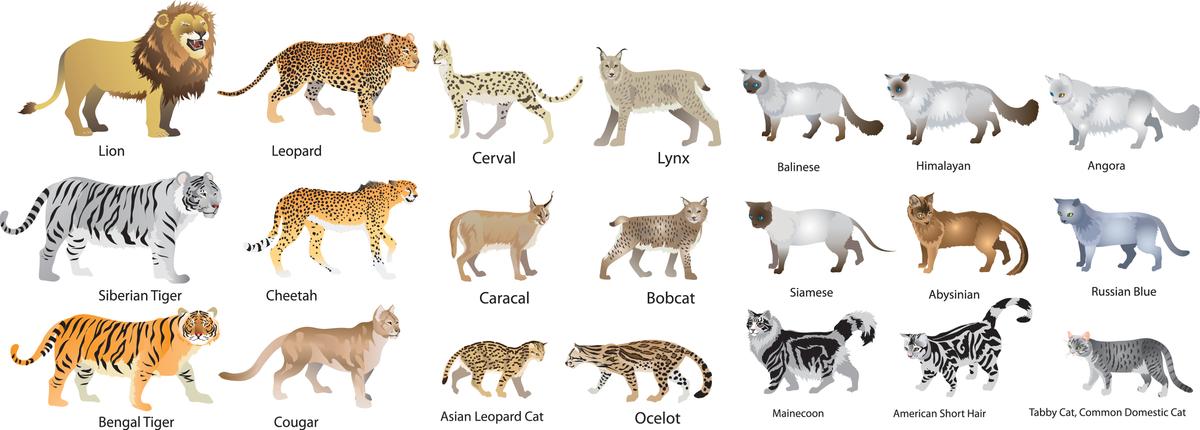
What family are cats in? The taxonomic family Felidae contains 37 feline species, ranging from pumas, jaguars, lions, and the domesticated house cat. All these species are considered as, in broader terms, “felids” or “cats.” Felines are native to all parts of the world except Antarctica and Australia (humans introduced them to these locations much later). This article will explain what characteristics make cats unique, which species fall into the broader Felidae family, and how to learn more about your cat’s unique genetic history.
Features of Animals in the Cat Family
Animals in the cat family have several physical traits distinguishing them from other mammals. Most notably, it is their body characteristics, sensitive whiskers, good vision, and eye membranes that reflect light.
Body Characteristics

The physical appearance differs for each cat family member, but some consistent features exist. Males are typically 5% to 10% larger than females. Except for the stubby-tailed lynx, a cat’s tail comprises almost one-third of its total length. Most felids can retract their paws, thanks to the ability to pivot the end bone of the toe where the claw is contained.
Sensitive Whiskers

Those trademark whiskers are not just found next to a feline’s nose. They can also be spotted around the ears, upper lip, forelegs, and eyes. Whiskers differ from normal hair as the follicles are packed with nerves and blood vessels, making them as sensitive as a human finger. They help cats navigate the world by balancing their bodies, “seeing” objects close-up, protecting the eyes from loose particles, and communicating emotions.
Good Vision
IMAGE PLACEMENT: https://www.shutterstock.com/image-photo/portrait-large-maine-coon-cat-on-1708473565
Even though cats struggle to see close up (hence why whiskers come in handy), they have adequate mid-vision and superb peripheral vision. They can see 200 degrees, whereas humans can only see 180 degrees. Felids also have exemplary night vision. More rods in a cat’s eye allow them to see six to eight times better in the dark than humans can.
Eye Membrane That Reflects Light

Have you ever wondered why a cat’s eyes “glow” in the dark? This is due to their tapetum lucidum, an extra layer covering the eyes, unique to the feline family. The tapetum lucidum bounces back light through the retina, increasing photoreceptors’ light availability. As a result, cats can see much better than humans in the dark, and also why shining a light in a human eye will not cause this glow.
Cat Family Categories Breakdown
Subfamily Felinae

The subfamily Felinae is made up of the “small cat” species. Most of these cats are smaller than their Pantherinae counterparts. This subfamily contains the most species, totaling over forty. This group also includes the most endangered cat species, the Iberian Lynx.
The most significant distinguishing factor in this group is the hyoid bone, which connects the tongue to the roof of the mouth. In small cats, this bone is tough, which prevents them from roaring but allows them to purr.
Subfamily Pantherinae

The subfamily Pantherinae comprises the “big cat” species. Even though they are physically larger in stature, this group is smaller in species count, with only seven in total.
Like the Felinae subfamily, this group's most distinguishing feature is the hyoid bone. The hyoid bone in big cats has an elastic segment that allows them to roar and purr, but this noise can only be made when they exhale.
Feline Family Species List
As previously noted, the cat family list can be divided into two subfamilies: big cats (pantherinae) and small cats (felinae). These lists include the genius, what each genius group is known for, and what species fall under them.
Big Cat Species Examples (Pantherinae)

Neofelis
Known for: Elongated skull. Lives in Southeast Asia.
Species: clouded leopard (Neofelis nebulosa), Sunda clouded leopard (Neofelis diardi)
Panthera
Known for: Bigger stature. A larger larynx adapted to roar loudly.
Species: tiger (Panthera tigris), lion (Panthera leo), jaguar (Panthera onca), leopard (Panthera pardus), Snow leopard (Panthera uncia)
Small Cat Species Examples (Felinae)

Acinonyx
Known for: Slim with long legs. Lives in open grasslands of Asia and Africa
Species: cheetah (Acinonyx jubatus)
Caracal
Known for: Long shoots of black hairs on the tips of pointed ears.
Species: caracal (Caracal caracal)
Catopuma
Known for: Reddish-brown fur with dark brown markings on the face. Lives in Asia.
Species: bay cat (Catopuma badia), Asian golden cat (Catopuma temminckii)
Felis
Known for: Wide, high head shape with narrow jaws and ears. Has a more diminutive stature.
Species: Chinese mountain cat (Felis bieti), domestic cat (Felis catus), jungle cat (Felis chaus), Pallas’s cat (Felis manul), sand cat (Felis margarita), black-footed cat (Felis nigripes), wildcat (Felis silvestris)
Leopardus
Known for: Spotted fur. Lives in the Americas.
Species: Pantanal cat (Leopardus braccatus), colocolo (Leopardus colocolo), Geoffroy’s cat (Leopardus geoffroyi), kodkod (Leopardus guigna), southern tigrina (Leopardus guttulus), Andean mountain cat (Leopardus jacobitus), pampas cat (Leopardus pajeros), ocelot (Leopardus pardalis), oncilla (Leopardus tigrinus), margay (Leopardus wiedii), Leptailurus
serval (Leptailurus serval)
Lynx
Known for: Short tails. Long tufts of fur on the tops of ears.
Species: Canada lynx (Lynx canadensis), Eurasian lynx (Lynx lynx), Iberian lynx (Lynx pardinus), bobcat (Lynx rufus)
Pardofelis
Known for: Long tails and short-shaped heads.
Species: marbled cat (Pardofelis marmorata)
Prionailurus
Known for: Lives in Asia. Forests are the preferred habitat
Species: Iriomote cat (Prionailurus iriomotensis), leopard cat (Prionailurus bengalensis), flat-headed cat (Prionailurus planiceps), rusty-spotted cat (Prionailurus rubiginosus), fishing cat (Prionailurus viverrinus)
Profelis
Known for: Lives in the rainforests of Central and West Africa.
Species: African golden cat (Profelis aurata)
Puma
Known for: Can be as large as cats in the Pantherinae subfamily.
Species: puma (Puma concolor), jaguarundi (Puma yagouaroundi)
Find Out More About Your Cat With Basepaws

Even though your cat may think of themselves as brazen as the lion or as swift as the cheetah, genetics show they are not as directly related as they would hope. However, you can learn more about your feline’s breed mix and characteristics through Basepaws. With the Basepaws Cat DNA test, you can find out which breeds of cats share your feline friend’s genetic similarity. The test compares your cat’s genetic code to a reference panel comprising thousands of cats, including fully sequenced DNA of cats from 21 top pedigree breeds.
Basepaws can determine whether your cat is at-risk for 43 genetic diseases from your cat's genetic results. Knowing this information beforehand can help prevent illness and keep your cat healthier and happier for longer. Basepaws also screens for your cat’s oral health to determine active dental disease (periodontal disease, tooth resorption, halitosis).
Better yet, Basepaws is quick and easy to use. In three easy steps - register your kit, collect a saliva sample from your cat's mouth, and send it back to our laboratory - our team can begin analyzing your cat's DNA. In 4-6 weeks, you will receive a digital report straight to your inbox.
Conclusion
The term “cat” doesn’t just mean your typical house cat but rather many members of the feline family. Despite the varying size, appearance, and location, these felids have common characteristics that tie the family together.
Isn’t it fascinating that the domesticated cat shares similar traits, such as eyesight and those signature whiskers, as, say, a lion or tiger?



